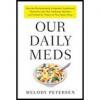Medication nation

Our Daily Meds:
THERE NOW exists a modest canon of books that expose and excoriate the pharmaceutical industry. The best ones are by industry insiders and physicians who have either participated in or witnessed the chicanery. Now along comes another muckraker, Our Daily Meds, but this time by a crack New York Times reporter—Melody Petersen—who covered the pharmaceutical beat for four years. Nothing escapes her critical eye: the obscene CEO salaries and profits, the push to prescribe more pills to children, the junk science, and the corruption of the medical profession.
As a reporter, Petersen had access to trade shows, drug launch events and parties, and meetings in hotel ballrooms with drug company executives and Wall Street investors. She interviewed CEOs and scientists, as well as patients maimed by medications they thought were safe. The author dug up testimony of a corporate whistle-blower at a Senate hearing and found damning corporate internal memos.
The book documents the unprecedented power of the pharmaceutical industry, which controls one of the most precious commodities—medicine. For millions of people, access to medicine is the difference between life and death. Petersen’s book opens with a stark example—sleeping sickness. Millions in Africa are infected with the parasitic disease, which crosses the blood-brain barrier and is always fatal but is easily cured by a medication called eflornithine. The drug maker Sanofi-Aventis halted production of the drug because it wasn’t “cost effective,” corporate-speak for there aren’t enough profits in selling drugs to poor people. The drug was then marketed to women with unwanted facial hair in developed countries. Sleeping sickness kills more than 40,000 Africans every year.
Our Daily Meds explains how drug companies want to create “lifelong medication users,” despite the fact that there is little to no scientific data that many of them are effective. There is Ritalin for children who can’t sit still, Cymbalta and Celexa for depression, and Neurontin for everything. But the drug peddlers don’t want to eliminate disease. Petersen quotes a stock analyst on this point, “We sometimes joke that when you’re doing a clinical trial, there are two possible disasters. The first disaster is if you kill people. The second disaster is if you cure them.”
In a “Medication Nation” like the United States, the advertisement of drugs is ubiquitous: public pay phones wrapped in plastic that advertise Seroquel for bipolar disorder; Viagra commercials shown at halftime during the Super Bowl; bags, mugs and pens embossed with drug company logos. For children, GlaxoSmithKline employed a smiling amphibian named Auggie the Froggie to hock its antibiotic Augmentin. Marketers at Abbott laboratories created a wrinkled bulldog named Bix to symbolize Biaxin. The millions spent on advertising increase sales, and, therefore, profits.
As Petersen recounts, a former executive with Abbott Laboratories, David C. Jones, explained to Edward Kennedy’s Senate committee how drug prices are set:
There is at least some assessment in terms of the options that the patient has available—the fewer the options, the higher the price; the greater the desperation, the greater the suffering, the higher the price. These are routine conversations that occur with virtually every drug that is introduced.
Perhaps the most disturbing revelations in Our Daily Meds are how profoundly the medical profession has been tainted by drug-company money. Most of the marketing budgets of drug companies are spent on influencing the prescribing practices of physicians. Doctors in every medical specialty are on the pharmaceutical company payroll as speakers, consultants, and researchers. Drug reps call them “key opinion leaders,” or just “KOLs.” They are lavished with gifts, cash, booze, and food. The KOLs are whisked off and pampered at spa weekends in exotic locations for “continuing medical education.” A study in 2003 found that the industry got 82 percent of the physicians they invited to an event to go when they offered cash.
Doctors insist that all the swag and soirées don’t influence what they prescribe, but study after study (many by the drug companies) show they’re wrong. According to Petersen, “Social scientists have found that gifts as small as a cup of coffee can change the behavior of the recipient in ways that he or she does not even realize.” And that is why the marketing firm called Thomson Physicians World could brag in a 2002 brochure that it had signed up more than twenty thousand physicians to speak on behalf of the drug industry. The avarice is sickening.
One chapter shows how science is manipulated to sell more drugs. A feeding chain of “medical education” firms have been spawned to create scientific “content”—articles, clinical trial reports, reviews of medicines (always positive)—solely to boost the sales of their clients’ drugs. The pieces are published in the most prestigious medical journals. More ominously, 50 percent of pharmaceutical trials have never been published. It’s in the DNA of the drug industry to hide the negative results of drug trials, and the consequences are lethal. Patients die.
In an epilogue, Petersen offers a number of excellent suggestions to curb the toxic side effects of the drug industry: Stop physicians from taking drug money, make science honest again, end the marketing of drugs, and stop the fraud. But who is going to stop them? The politicians who accept millions of dollars in campaign contributions from the pharmaceutical industry? The Senators who worked with drug company lobbyists to write Medicare Part D, which makes it illegal for the government to negotiate drug prices (it really pays off to have two lobbyists for every member of Congress)? The nearly 95 percent of doctors who line up like pigs to feed at the money trough? Or Ted Kennedy, who holds hearings on drug company price gouging and malfeasance and does nothing? The change is not going to come from the top.


 Facebook
Facebook Twitter
Twitter Google+
Google+ Tumblr
Tumblr Digg
Digg Reddit
Reddit StumbleUpon
StumbleUpon
